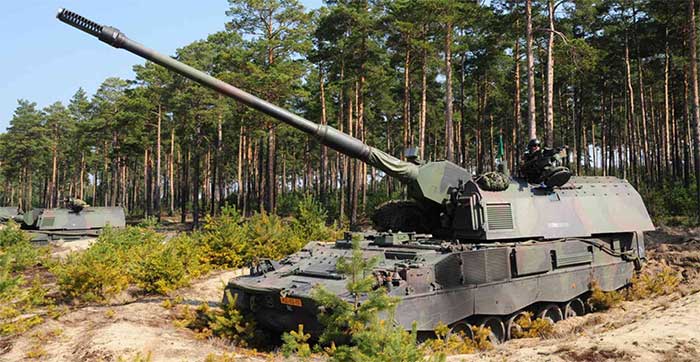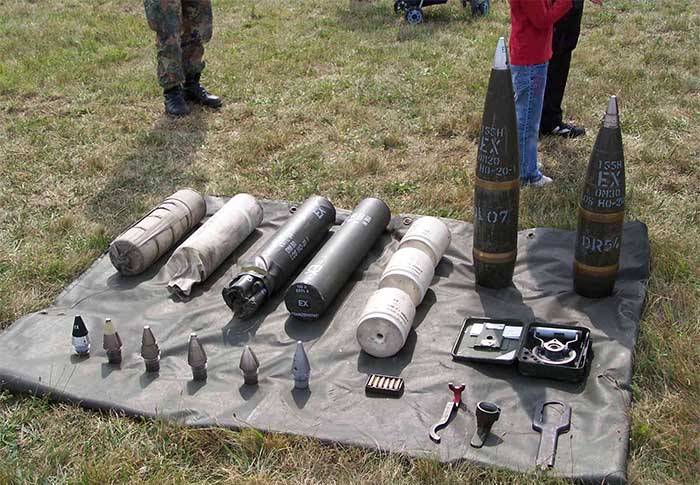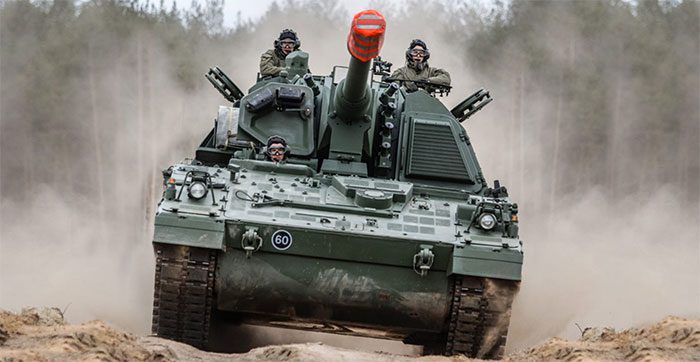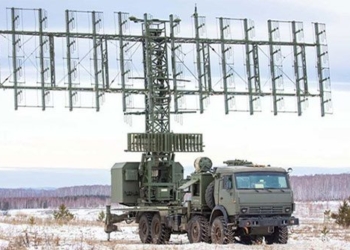After France sent CAESAR self-propelled howitzers, Germany has also decided to send the Panzerhaubitze 2000 (PzH 2000) self-propelled howitzers to Ukraine. This is currently one of the most advanced artillery systems used by the German army since 1998.
Germany will send 7 PzH 2000 systems to Ukraine along with training support. This information was announced by Germany’s Minister of Defense, Christine Lambrecht, on Saturday during her visit to Slovakia to meet German soldiers stationed there.

The PzH 2000 is a 155mm self-propelled howitzer.
The PzH 2000 is a 155mm self-propelled howitzer developed by Kraus-Maffei Wegmann (KMW) and Rheinmetall Landsysteme for the German military. The development of the PzH 2000 began in 1986 when Italy, the UK, and Germany agreed to terminate the existing SP70 self-propelled howitzer program due to reliability issues, design flaws, and financial problems. German defense companies were tasked with submitting proposals for a self-propelled howitzer using a 52 caliber barrel instead of the 39 caliber used in the old program. KMW eventually won the contract to manufacture the PzH 2000 after merging with Wegmann.
The development of the PzH 2000 began in 1987, and the first prototype was unveiled in 1993. The German army ordered 185 PzH 2000 self-propelled howitzers, with the first units delivered in 1998, subsequently exporting to countries such as Croatia, Greece, Italy, Lithuania, Hungary, the Netherlands, and Qatar.

This howitzer uses a modular charge loading system (MTLS).
The main component of the PzH 2000 is a 155mm/L52 long barrel howitzer designed to JBMOU standards by the military contractor Rheinmetall. The barrel is chrome-plated along its entire length of 8 meters, including the muzzle brake. This howitzer employs a modular charge loading system (MTLS), capable of using up to 6 modular charges. By utilizing multiple modular charges, the PzH 2000 can achieve an impressive range of 30 – 36 km with DM121 Boattail shells, 40 – 47 km with base bleed shells (which release gas into low-pressure areas to reduce drag), and up to 67 km with M20005 V-LAP rocket-assisted shells. Additionally, the PzH 2000 can fire the SMArt 155 projectile, an intelligent shell that releases two submunitions which parachute before accurately targeting armored vehicles using infrared and millimeter wave radar. In 2013, the PzH 2000 successfully tested the US’s long-range guided artillery shell, the M982 Excalibur.
The fire control system of the PzH operates in automatic mode thanks to an external command and control system connected via encrypted radio data links. In this mode, a MICMOS computer developed by EADS (Daimler Chrysler Aerospace) controls the fire, with ballistic data provided by the computer, and the turret automatically rotates and adjusts the angle, allowing the crew to operate with just 2 members instead of the standard 5, which includes a commander, driver, gunner, and 2 ammunition loaders.
Moreover, the PzH 2000 is regarded as one of the most advanced artillery systems globally due to its use of the Multiple Round Simultaneous Impact (MRSI) system. This system allows the howitzer to fire 5 shells simultaneously at different elevations, enabling the warheads to hit a target almost simultaneously within a 1.5-second window.
The PzH 2000 is an automatic loading self-propelled howitzer, capable of carrying 60 shells pre-loaded on a conveyor system, which can be fully loaded by just 2 ammunition loaders in 12 minutes. The gunner only needs to manually load the modular charge; the rest of the operations, including placing the shell on the tray, loading, and chambering, are done automatically.
The firing rate of the PzH 2000 reaches 3 rounds in 9 seconds, 10 – 12 rounds per minute, and 20 rounds in 1 minute and 47 seconds. A battery of 24 PzH 2000s can fire 120 rounds in 60 seconds.
It is important to note that ammunition loaders for the PzH 2000 are trained rigorously because there is no room for error during the loading process; a single misstep could result in serious injury. In the video above, you can see the automated loading process of the PzH 2000, where the loader must place the modular charge manually into the cannon’s breech and has only 5 seconds before the rear door closes.

The artillery system can achieve speeds of 60 km/h, with a range of 420km.
The artillery system is mounted on a tracked chassis, borrowing some components from the Leopard 2 main battle tank, such as interchangeable tracks. It also has thick steel armor that can withstand 14.5 mm bullets when fired directly, as well as small arms fire and shrapnel. In case of need, explosive reactive armor (ERA) can be added. For self-defense, the PzH 2000 is equipped with a 7.62 mm MG3 machine gun. It uses a supercharged diesel engine, the MTU MT 881 Ka-500, providing 1000 horsepower, with an auxiliary power unit to operate all systems in case the main engine fails. The artillery system can reach speeds of 60 km/h, with a range of 420 km.
The PzH 2000 saw its first real combat in August 2006 with the Royal Netherlands Army, targeting Taliban positions in Kandahar, Afghanistan. The PzH 2000 systems were tasked with providing artillery support during Operation Medusa. Subsequently, the PzH 2000 was regularly used to support coalition forces in Uruzgan, Afghanistan, as well as in the Battle of Chora in 2007.




















































